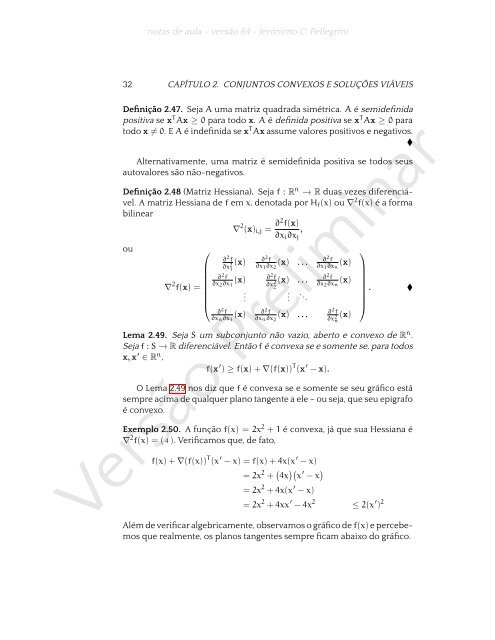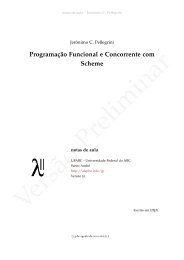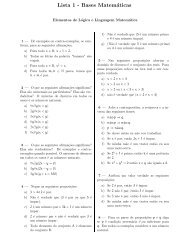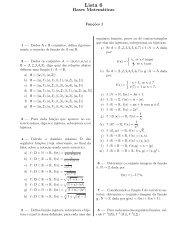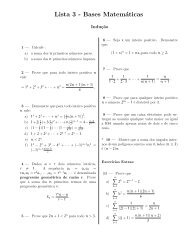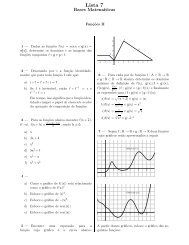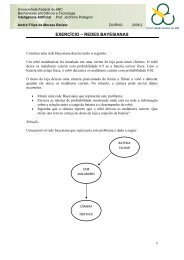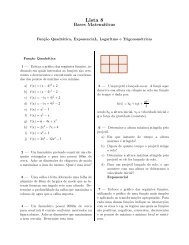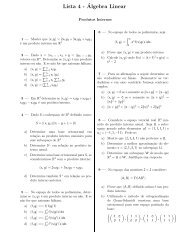Programação Linear (e rudimentos de otimização não-linear)
Programação Linear (e rudimentos de otimização não-linear)
Programação Linear (e rudimentos de otimização não-linear)
Create successful ePaper yourself
Turn your PDF publications into a flip-book with our unique Google optimized e-Paper software.
notas <strong>de</strong> aula – versão 64 - Jerônimo C. Pellegrini<br />
32 CAPÍTULO 2. CONJUNTOS CONVEXOS E SOLUÇÕES VIÁVEIS<br />
Definição 2.47. Seja A uma matriz quadrada simétrica. A é semi<strong>de</strong>finida<br />
positiva se x T Ax ≥ 0 para todo x. A é <strong>de</strong>finida positiva se x T Ax ≥ 0 para<br />
todo x ≠ 0. E A é in<strong>de</strong>finida se x T Ax assume valores positivos e negativos.<br />
<br />
Alternativamente, uma matriz é semi<strong>de</strong>finida positiva se todos seus<br />
autovalores são não-negativos.<br />
Definição 2.48 (Matriz Hessiana). Seja f : R n → R duas vezes diferenciável.<br />
A matriz Hessiana <strong>de</strong> f em x, <strong>de</strong>notada por H f (x) ou ∇ 2 f(x) é a forma<br />
bi<strong>linear</strong><br />
∇ 2 (x) i,j = ∂2 f(x)<br />
,<br />
∂x i ∂x j<br />
ou<br />
⎛<br />
∂ 2 f<br />
(x)<br />
∂x 2 1<br />
∂<br />
∇ 2 2 f<br />
∂x<br />
f(x) =<br />
2 ∂x 1<br />
(x)<br />
⎜ .<br />
⎝<br />
∂ 2 f<br />
∂x n∂x 1<br />
(x)<br />
∂ 2 f<br />
∂<br />
∂x 1 ∂x 2<br />
(x) . . . 2 f<br />
∂ 2 f<br />
∂x 2 2<br />
∂x 1 ∂x n<br />
(x)<br />
(x) . . .<br />
∂ 2 f<br />
∂x 2 ∂x n<br />
(x)<br />
.<br />
. ..<br />
∂ 2 f<br />
∂<br />
∂x n∂x 2<br />
(x) . . . 2 f<br />
∂x 2 n<br />
(x)<br />
Versão Preliminar<br />
⎞<br />
. <br />
⎟<br />
⎠<br />
Lema 2.49. Seja S um subconjunto não vazio, aberto e convexo <strong>de</strong> R n .<br />
Seja f : S → R diferenciável. Então f é convexa se e somente se, para todos<br />
x, x ′ ∈ R n ,<br />
f(x ′ ) ≥ f(x) + ∇(f(x)) T (x ′ − x).<br />
O Lema 2.49 nos diz que f é convexa se e somente se seu gráfico está<br />
sempre acima <strong>de</strong> qualquer plano tangente a ele – ou seja, que seu epigrafo<br />
é convexo.<br />
Exemplo 2.50. A função f(x) = 2x 2 + 1 é convexa, já que sua Hessiana é<br />
∇ 2 f(x) = ( 4 ). Verificamos que, <strong>de</strong> fato,<br />
f(x) + ∇(f(x)) T (x ′ − x) = f(x) + 4x(x ′ − x)<br />
= 2x 2 + ( 4x )( x ′ − x )<br />
= 2x 2 + 4x(x ′ − x)<br />
= 2x 2 + 4xx ′ − 4x 2 ≤ 2(x ′ ) 2<br />
Além <strong>de</strong> verificar algebricamente, observamos o gráfico <strong>de</strong> f(x) e percebemos<br />
que realmente, os planos tangentes sempre ficam abaixo do gráfico.


